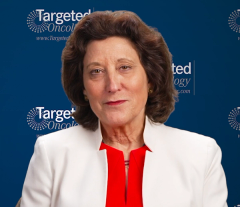
Treatment Options for HR+/HER2- Metastatic Breast Cancer with Disease Progression on Standard-of-Care Therapy
A comprehensive review of treatment options for patients with HR+/HER2- metastatic breast cancer who experience disease progression on standard-of-care therapies such as combination CDK4/6 and aromatase inhibitors.
Episodes in this series

Case: A 57-Year-Old Woman with HR+/HER2- Metastatic Breast Cancer
Presentation
- A 57-year-old postmenopausal woman with a personal history of breast cancer presented with sternal pain during a followup appointment
Patient history
- She was diagnosed with stage I ER+/HER2- disease 8 years ago, at 49 years of age
- At the time, she was prescribed 5 years of adjuvant letrozole treatment, which she completed 3 years ago
Physical exam, clinical workup, and imaging
- Mid-sternum tenderness to palpation
- Slight elevation in ALP, all other lab testing unremarkable
- Bone scan showed uptake in sternum, scapula, lumbar spine, iliac crest
- Chest/abdomen/pelvis CT revealed sclerotic bone lesions
- Iliac bone biopsy confirmed ER+/HER2- metastatic breast cancer
- NGS on biopsy sample was negative for mutations
- ECOG PS=1
Treatment/followup
- The patient received letrozole and ribociclib as first-line treatment for metastatic disease
- 24 months after treatment initiation, CT showed enlargement of bone lesions and a single new 2-cm liver lesion
- Liquid biopsy/ctDNA testing revealed an ESR1 mutation
- The patient then started on elacestrant 345 mg once daily
Transcript:
Hope Rugo, MD, FASCO: One question that comes up is what are the treatment options, as we treat patients sequentially with endocrine therapy? If we focus on this patient and our treatment decisions in thinking about her disease, we know that she has metastatic disease to bone. She had bone-only disease. She now has a single lesion on liver, and she’s asymptomatic. Her liver function tests are normal, which is helpful, and she had a long response to the CDK4/6 inhibitors and aromatase inhibitors, indicating endocrine-sensitive disease. I don’t classify these patients as being endocrine resistant. They’re just resistant to their therapy.
Our treatment options include giving fulvestrant alone and fulvestrant with a targeted agent. She doesn’t have a PIK3CA mutation, so you could consider fulvestrant and everolimus. You could also consider fulvestrant and continue with a different CDK4/6 inhibitor. We’re waiting for data from the postMONARCH trial, which looked at giving abemaciclib after first-line endocrine therapy and a CDK4/6 inhibitor. To date, we only have data from an interesting phase 2 trial, the MAINTAIN trial, but it’s not at all definitive about the benefit of CDK4/6 inhibitors. Interestingly, in patients who had ESR1 mutations and others, in this tiny number of patients, it looked as if the continuation of a different CDK4/6 inhibitor wasn’t effective. We obviously need larger data sets.
Now we have a new option, recently approved, with the oral SERD [selective estrogen receptor degrader] elacestrant. That’s an interesting question in this patient. Because she has had a long response to endocrine therapy, she seems to have endocrine-responsive disease that’s progressed slowly on her first-line therapy. Elacestrant is a very nice option for her, an oral therapy. She has the ESR1 mutation, which makes her eligible for the treatment. The subset data from the EMERALD trial suggest that patients, who have a long response to their initial CDK4/6 inhibitor and endocrine therapy, benefit substantially from single-agent elacestrant.
That’s nice because you don’t have the toxicities of the targeted agents to monitor for, prevent, or treat. That’s an option to consider for this patient. It allows them not to come in for injections of fulvestrant, which require visits to the cancer center. We see patients, but when they’re doing well we don’t usually have to see them every month. We might see them every 6 or 8 weeks. We’re not tying them to the infusion center. Some patients complain about the pain from the injections. I’m surprised more patients don’t complain about pain from injection. That’s another consideration.
The toxicity of elacestrant seems to be fairly modest. We can manage nausea pretty well with antiemetics. We have drugs like olanzapine that can be given at bedtime that help with nausea a lot. That’s a reasonable treatment option for a patient like this.
Transcript edited for clarity.









































